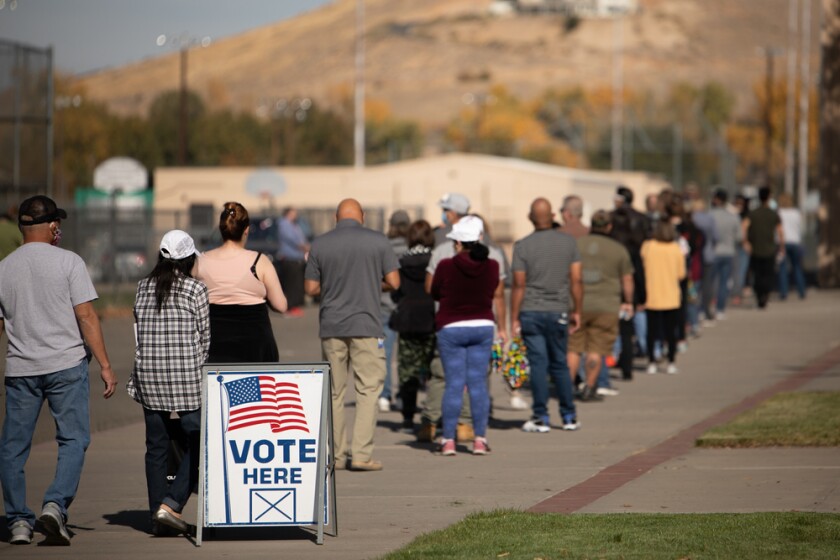These major pieces of legislation provide the capstone for Biden’s surprisingly successful summer. Biden signed the first significant gun-control legislation in years, has happily watched inflation and gas prices start to come down and oversaw the drone strike that killed terrorist leader Ayman al-Zawahiri.
“Democrats try a new campaign strategy — getting things done,” ran a headline in the Los Angeles Times last Friday.
Biden had suffered almost nothing but bad news for most of the entire past year, ever since he pulled the U.S. out of Afghanistan. Lately, he’s looked more like a gambler on a lucky streak, which has given Democrats a renewed sense of optimism about their prospects in the midterms. “If the election were held today, we’d pick up a few seats,” Chuck Schumer, the leader of the Senate Democrats, said last week on The Black Eagle podcast.
Politically speaking, Democrats caught a break when the Supreme Court overturned Roe v. Wade, finding that there is no constitutional right to abortion. That led to a big win on an abortion measure in Kansas and has boosted the party’s hopes among women and young voters. After spending less than $1 million on ads about abortion in the entirety of the 2018 midterm election season, Democrats have spent more than $30 million on such ads just since the court’s decision in Dobbs v. Jackson Women’s Health Organization was made official, less than two months ago, according to The New York Times.
“That makes it hard for Republicans, especially in suburban districts,” says Matthew Hennessy, a Democratic consultant based in Connecticut. “The issues around abortion, gun control, inflation and gas prices, those all seem to be breaking Biden’s way, and the Democrats’ way.”
Hennessy concedes that about 45 days ago, Democrats looked like they were heading into a world of hurt. The fundamentals that matter most in elections, such as presidential approval ratings and economic indicators, were all pointing down for the party. Consumer sentiment has ticked up a bit, although it remains well below where it was this time last year.
“It’s nice to be moving forward into Labor Day and the final stretch of the election season without certain albatrosses around our necks, like high gas prices and inflation, and with that extra motivation that the fall of Roe has given a lot of voters, especially women voters,” says Carolyn Fiddler, a former Democratic official now with Courier Newsroom, a media company.
It’s probably still too early for Democrats to dust off their scratchy old records of “Happy Days Are Here Again.” Democrats who are talking about their fortunes suddenly turning around are whistling past the graveyard, says David Carney, a GOP consultant based in New Hampshire. “The facts belie the wishful thinking of the Democrats,” he says. “Whether we win 20 (House) seats or 50 seats, I’m pretty sure Nancy Pelosi will be retired.”
As Carney’s remark suggests, Republicans may not end up enjoying the landslide they were expecting just a few weeks ago, but it’s still a safe bet the party will end the year in a stronger position than it occupies right now. Redistricting will help the party at both the congressional and legislative levels and the reality is that Biden’s approval ratings remain abysmal — lower than President Donald Trump’s were at this point in 2018, when his party lost 40 House seats. “In every poll I’ve ever seen, independents are still very negative about Biden,” says John Couvillon, a GOP pollster based in Louisiana.
Still, after a seemingly unending run of bad news, Democrats are glad finally to be putting some points on the board. The president’s party — any president’s party — is bound to lose seats in midterms, but perhaps Democrats can now count on catching a few more breaks than they’d expected.
“The election was always going to be uphill for Democrats, no matter what,” Fiddler says. “Now maybe the grade of the hill will decrease a little bit, but it’s still going to be hard.”
GOP Leaves Some Openings
Schumer isn’t the only one bullish on the Democrats’ chances in the U.S. Senate. The chamber is currently tied but controlled by Democrats thanks to Vice President Kamala Harris’ tiebreaking vote. The forecasting site FiveThirtyEight currently rates the Democrats as “slightly favored” to win the Senate majority in November.
Republicans have done Democrats a favor by nominating candidates for both Senate and governor who are exceptionally inexperienced. Many Republicans nominated for top offices have never held any elective position before. “The Republicans are certainly taking a chance this year with regard to the quality of their nominees,” Couvillon says. “You have a lot of these candidates who are quite strident in their views, or they’re speaking a message that is quite different than you would have expected from prior Republican candidates.”
The U.S. House is also essentially tied, with Republicans needing a net win of just four seats to take control. There, too, Democratic fortunes have improved. Generic congressional polling, which had slightly favored the GOP all year, is now a jump ball. Since the Dobbs decision, Democrats running in special House elections in Minnesota and Nebraska have outperformed Biden’s 2020 vote totals in those districts, although they haven’t actually, you know, won.
Then, as always seems to be the case in contemporary politics, there’s the Trump factor. Republicans have strongly and almost unanimously defended the former president in light of last week’s search of his home in Florida by the FBI. “Republicans are even more engaged,” Carney says. “Trump claims to be a victim, and this offers proof.”
It will be a while before the Trump legal saga plays out, but Democrats hope that his renewed visibility — especially given the circumstances — will motivate not just their own voters, but the suburban women who soured on him in 2020.
“Democrats have to walk that fine line, where we talk about accomplishments — which is what the White House wants to do — but also reminding voters that our opponents want to bring back this guy who is a lawbreaker,” says Hennessy, the Democratic consultant.
Biden’s Dead Weight
If Democrats have real reasons for optimism, there are still key factors pointing to Republican success.
The most important number in politics is the president’s approval rating. Biden’s numbers have ticked up a bit, but only to 40 percent, with far more Americans unhappy about the job he’s doing than not. Some Democrats can and no doubt will run ahead of Biden’s numbers in their own districts and states. Things certainly don’t look as bad as they did last November, when the Democratic candidates for governor in both Virginia and November ran about a dozen points behind Biden’s share of the vote in those states in 2020.
But Democrats have to make up an awful lot of ground when their leader is so deep underwater. In recent cycles, there’s been remarkably little ticket-splitting. There are only 16 U.S. House members left representing districts won by the other party for president in 2020. In 2016 and 2020 combined, a grand total of one Senate candidate won a state her party’s presidential candidate failed to win (Susan Collins of Maine).
Some Democrats are talking openly about their wish that Biden won’t run for re-election. They’re not exactly tripping over each other to ask him to come out and campaign for them, either.
Biden sounded tin-eared last week when he boasted about inflation reaching zero in July. That may be true from a technical standpoint, but even if pricing floodwaters have crested, they haven’t receded. Gas prices have come down but still have a ways to go before they reach the averages seen last year.
“There’s nobody in America who thinks there’s zero inflation, particularly if they are coming back from the grocery store or the gas station,” Carney says.
Political Gravity Against Democrats
When parties get struck by political waves, those waves usually form late. The scope of a landslide year generally doesn’t become clear until the final weeks or days of a campaign.
Undecided voters almost always break against the party in power in Washington. If they liked what was going on, they wouldn’t be undecided. The party out of power has done better in actual voting in every election dating back to 2006 than their showing in generic ballot polling suggested this far out.
In the fall, pollsters shift from trying to measure opinion among all registered voters to screen for likely voters. They’ve made plenty of mistakes in recent years, but there’s no question that Republicans have been voting in greater numbers in primaries this year than Democrats. It’s a tangible measure of voting enthusiasm.
In 2018, the fact that Democrats accounted for a larger share of the primary electorate was a harbinger of their success that November. But now it’s Republicans who are voting more. According to figures compiled by Couvillon, the Republican share of the overall primary vote has grown from 47 percent in 2018 to 53 percent in primaries so far this year.
Did Dobbs matter? It certainly boosted Democratic registration and turnout in Kansas. Overall, however, it hasn’t shifted the numbers all that much. In 25 primaries conducted prior to Dobbs, Republicans cast 53.4 percent of the vote. In the 12 primaries since Dobbs, they’ve cast 51.5 percent of the vote.
For Democrats, it’s an improvement, but, as with the special congressional elections, it’s not exactly a win.
Related Articles














